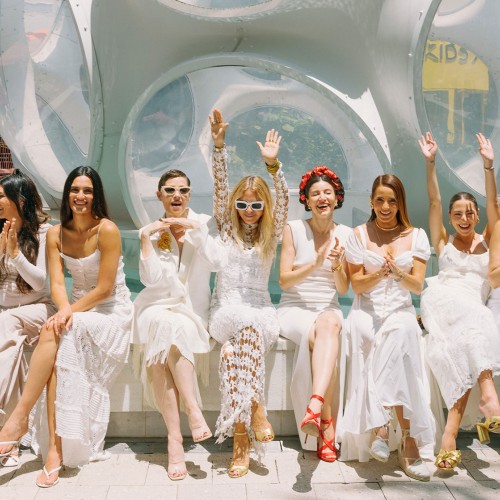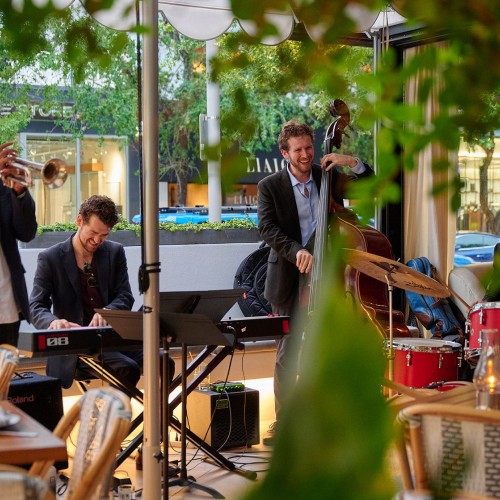6:30pm: Conversation with the artists
7:30-9:30pm: Opening reception
Gallery Hours: Tuesday-Saturday, 10am-5pm
Exhibitions on view through June 13, 2015
ROBERTO GÓMEZ: WHAT HAPPENS WHEN NOTHING HAPPENS
Locust Projects is pleased to present What Happens When Nothing Happens, a new site-specific work by Miami-based artist Roberto Gómez. For his first public solo exhibition, Gómez has crisscrossed Locust Projects’ main space with clothesline, on which he has hung a series of cloth-like objects made from layers of latex paint. Gómez blurs the boundary between painting and sculpture, emphasizing the physicality and materiality of paint by utilizing it as a three-dimensional element. He plays with the audience’s expectations by presenting objects made of paint “masquerading” as cloth, in a configuration more often encountered outdoors than in.
What Happens When Nothing Happens builds upon Gómez’s works on canvas, created through the repeated application of layers of found paint sourced from local chemical waste management sites. At Locust Projects, Gómez has done away with the traditional canvas support, creating objects by pouring paint directly onto plastic sheets placed on the ground. Once the paint has started to dry, he peels it away from the plastic and manipulates it into the desired shape, which can be hung over a line. The repeated acts of pouring, peeling, molding and hanging reflect the repetitious character of many everyday tasks and can seem “work-like”, but the production of Gómez’s objects also has some of the qualities of “play”. Physical and aesthetic qualities are dictated by the intrinsic characteristics of the artist’s found materials (such as color and paint type), while Gómez chooses which colors to combine, and manipulates the paint into its final form, producing each object through a balance of serendipity and control.
Gómez’s practice interrogates the ways in which quotidian objects and actions structure daily life, and reflect social behaviors. Clotheslines intersect the landscape of many countries across the world, including Costa Rica where Gómez grew up, yet while washing and drying clothes is a repeated action that punctuates our lives, in some places it is rare to see laundry hanging outside. The presence — or lack — of clotheslines in a landscape can be an indicator of culture, class and socio-economic status. Through the familiar sight of laundry hanging on the line, Gómez questions our experience of daily life (and its relationship to art) and playfully explores the potential of the banal to become extraordinary.
PROJECT ROOM: MIA FEUER: MESH
Locust Projects is pleased to present Mesh, a new exhibition by Canadian-born, California-based artist Mia Feuer. Spanning three geographical sites — Miami and the Gulf Coast, Calgary, and the Arctic Circle — Feuer explores the interconnections between these places through a sculptural and sound installation.
Working with a 3D scanner for the first time, Feuer has scanned areas of land that will soon be washed away into the Gulf of Mexico. Rendered in salt, these 3D scans are presented below hanging objects made from Styrofoam and concrete, and accompanied by live underwater sound recordings of glaciers melting and calving in the Arctic Circle. Feuer links this occurrence to Calgary, the economic epicenter of the Canadian oil industry and the origin of the proposed Keystone XL pipeline, and then to Miami, one of the most vulnerable cities in the world to rising sea levels and climate change. The sound recording from the Arctic Circle is an important component of Feuer’s concurrent sculptural installations in Miami and Calgary, as it acts as an external trigger that activates a physical change, resulting in the dripping of an indigo blue aniline dye onto the salt and the gallery floor. This particular dye was one of the first substances to be synthetically produced through an industrial process.
Feuer is interested in sites where humans’ actions have visibly impacted upon the landscape. Her work makes connections between our dependency upon the hydrocarbon industry and petroleum derivatives, and the rapid and often catastrophic changes that this can cause. Recently Feuer has been conducting research on the federally unrecognized Biloxi Chitimacha-Choctaw Indian tribes, the Pointe au Chien and Isle de Jean Charles, who live among the bayous of southern Louisiana. These coastal communities are experiencing an unprecedented loss of land due to aggressive tides, salt water erosion, soil composition fluctuations, rising sea levels, and the increased frequency of extreme weather, such as hurricanes. Above all, these tribes have also had to cope with devastating environmental impacts resulting from the actions of the petroleum industry, such as canal dredging and construction, and large-scale oil spills.
This project was developed in association with Grant Deane, a Research Oceanographer from the Scripps Institute of Oceanography in San Diego, California. Mesh is part of an interrelated solo exhibition Synthetic Seasons, opening at the Esker Foundation in Calgary, Canada, on May 22, 2015.



